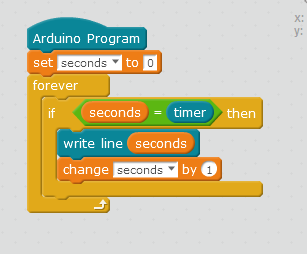
- Arduino millis source code how to#
- Arduino millis source code movie#
- Arduino millis source code manual#
- Arduino millis source code software#
- Arduino millis source code code#
Having understood the basic principle of non-blocking timing based on millis() makes it easy to understand. Trying to see a "delay-analog-thing" in millis() makes it hard to understand millis() Otherwise you might try to "see" a "delay-analog-thing" in the millis()-code which it really isn't


You have to understand the difference first and then look into the code. It does not use any hardware timers, it uses the Arduino millis() and micros() functions to store the start time. The basic principle of non-blocking timing is fundamental different from using delay() The start and end values do not matter, rather it is the difference between them that you are interested in. Now there is a technique of non-blocking timing. You never need to reset millis (), just save its value when an action happens and compare its value later with the value previously saved to determine how much time has passed.
Arduino millis source code code#
As long as the delay is "delaying" nothing else of the code can be executed. There is the hard way of understanding posting a link to long articleĪnd there is a more easy way to understand the basic principle first:Īs an allday example with easy to follow numbersĭelay() is blocking.
Arduino millis source code how to#
It describes in detail the source code of the timer files and also shows you how to build a finite state machine that is able to do your job reliably.
Arduino millis source code manual#
The program contains a finite state machine to do the job = simple way to manage complex automation jobs.Īnd there is a 40 page step by step manual (including demo sketches) how to do. The application contains blinking led's that blink in parallel with the main program running.
Arduino millis source code movie#
This movie shows a peristaltic pump that is driven by a pulse width solid state relay. It is part of a tutorial demo I have put on the Arduino project hub. (the code below inverts 2 booleans, one each 250ms and one each 500ms creating blinkbits with variable frequency). The millis function returns the number of milliseconds that your Arduino board has been powered up. Var client = net.There is a simple way to create timers: you need to add to 2 files to your sketch and then you can write code like below (code that does not uses waits and does not use millis() as wawiTimer encapsulates millis(). At 9600 baud, you’ll see that the Arduino is only busy for about 20 milliseconds in the first chunk of code, but busy for 93 milliseconds in the next. Var packetCount = parseInt(process.argv) Īssert(!isNaN(packetCount), 'bad packet count') Ĭonsole.log('packet count: ' + packetCount) Here’s a simple example that demonstrations: How to properly use Serial.flush () (hint: it’s for TRANSMIT, not RECEIVE) How long Serial.print ()s can tie up the Arduino. millis(), micros() - Stardard Arduino functions for the system time in. We make projects with: ESP32, ESP8266, Arduino, Raspberry Pi. Initial benchmarks have shown C++ code compiled by Arduino tends to achieve 2. Var packetSize = parseInt(process.argv) Īssert(!isNaN(packetSize), 'bad packet size') Ĭonsole.log('packet size: ' + packetSize) Random Nerd Tutorials helps makers, hobbyists and engineers build electronics projects. Var server = net.createServer(function(socket) Ĭonsole.log('options: ' + JSON.stringify(options))
Arduino millis source code software#
Here is the code:Īssert( = 4, 'node server.js ') After you build the circuit plug your board into your computer, start the Arduino Software (IDE), and enter the code below. I created a simple Node.js server application that could be connected to via TCP socket or Unix domain socket. Both client and server are written in Node.js and can only be as efficient as the Node.js runtime.Īll code in this post is available at: /nicmcd/uds_vs_tcp Server Application This number will overflow (go back to zero), after approximately 50 days. time millis () // Returns the number of milliseconds passed since the Arduino board began running the current program.

This post covers my experiments and test results.įirst off, is a disclaimer. To do this, the millis () function is most commonly used. I wanted to know how to reduce the CPU utilization of the machine, so I ran a few experiments to compare the efficiency between unix domain sockets and TCP sockets using the loopback interface. A recent project I was working on used Node.js with two communicating processes on the same machine. They can use regular TCP sockets, UDP sockets, unix domain sockets, or shared memory. Two communicating processes on a single machine have a few options.


 0 kommentar(er)
0 kommentar(er)
